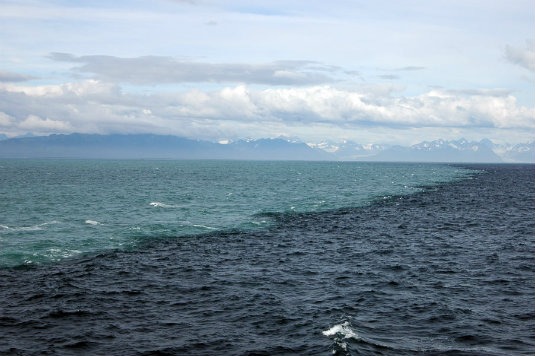

Exploring The Myth Of Where Two Oceans Meet In The Gulf Of Alaska
Have you ever seen stunning photographs that claim to show the moment when two oceans meet in the Gulf of Alaska? These captivating images have circulated widely on social media, sparking curiosity and awe. However, what if I told you that these pictures might not represent what they appear to? In this article, we will delve into the fascinating realities behind these photographs and clarify the misconceptions surrounding this natural phenomenon.
Since the first viral image was taken by ocean sciences professor Ken Bruland in 2007 during a research cruise, many have shared it as evidence of a spectacular point where two oceans converge. But the truth is, the images depict a very different story rooted in the dynamics of glacial rivers and ocean currents. Join me as we uncover the science behind these mesmerizing visuals and the reality they represent.
As we explore the details and intricacies of this phenomenon, we will learn about the processes that shape our oceans and how sediment-laden glacial rivers contribute to the mixing of waters. The more we understand this natural occurrence, the better we can appreciate the beauty and complexity of our planet's ecosystems. Let’s embark on this enlightening journey together!
What You Will Learn
- The origin of the viral photograph claiming to show two oceans meeting.
- The scientific explanation behind the visuals in the images.
- Common misconceptions regarding this phenomenon.
- The dynamic nature of ocean currents and their impact on water mixing.

Photographs purportedly showing "the place where two oceans meet" in the Gulf of Alaska have circulated online for several years. Although the images are real, there are several misconceptions about what they actually depict. The first photograph of this phenomenon to go viral was taken by Ken Bruland, a professor of ocean sciences at the University of California-Santa Cruz, during a research cruise in 2007:
"Glacier rivers in the summertime are like buzzsaws eroding away the mountains there," Bruland said. "In the process, they lift up all this material — they call it glacial flour — that can be carried out."
Once these glacial rivers pour out into the larger body of water, they are picked up by ocean currents, moving east to west, and begin to circulate there. This is one of the primary methods that iron — found in the clay and sediment of the glacial runoff — is transported to iron-deprived regions in the middle of the Gulf of Alaska.
Photographer Kent Smith captured another amazing image of the "place where two oceans meet" during a similar cruise in 2010:
@Chinmayi WHERE TWO OCEANS MEET These two bodies of water were merging in the middle of The Gulf of Alaska @Chinmayi pic.twitter.com/uv4iPb58oM
— S G Balaji (@sgbalaji2000) May 3, 2013
Another misconception associated with these types of photographs is the notion that they document a permanent location off the coast of Alaska. This is not true: in addition to the fact that ocean currents are constantly shifting, Bruland says that this "border" will eventually fade as the iron-rich waters from glacial rivers mix with the ocean.
As for that specific photo, Bruland said that it shows the plume of water pouring out from one of these sediment-rich rivers and meeting with the general ocean water. It's also a falsehood that these two types of water don't mix at all, he said.
These images are genuine and capture what occurs when two bodies of water, one rich with glacial flour, begin to merge. The photographs do not, however, depict a static location in the Gulf of Alaska where "two oceans meet."
Sources
Anderson, Ben "Mythbusting 'The Place Where Two Oceans Meet' in the Gulf of Alaska."
Alaska Dispatch News. 5 February 2013.
Anderson, Ben "USGS Researchers Participate in Research Cruise Studying Iron Biogeochemistry in the Gulf of Alaska."
U.S. Geological Survey. March 2008.
Unraveling The Myth Behind Louis Armstrong's Nickname "Satchmo"
Unraveling The Neiman Marcus Cookie Urban Legend
Colin Kaepernick's Controversial Sock Choice: A Political Statement
